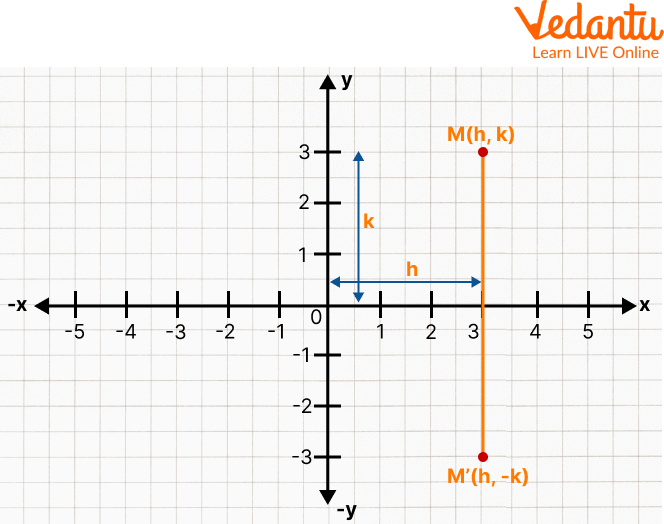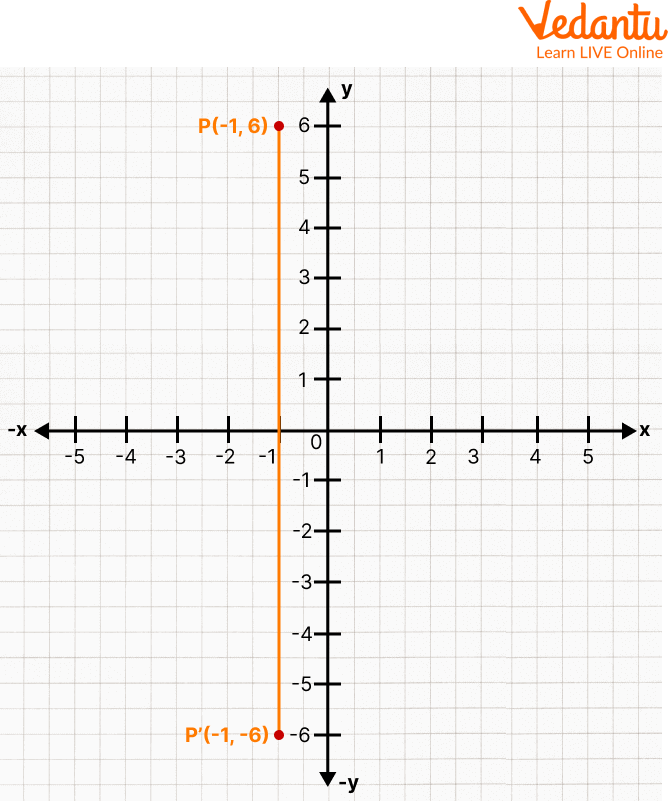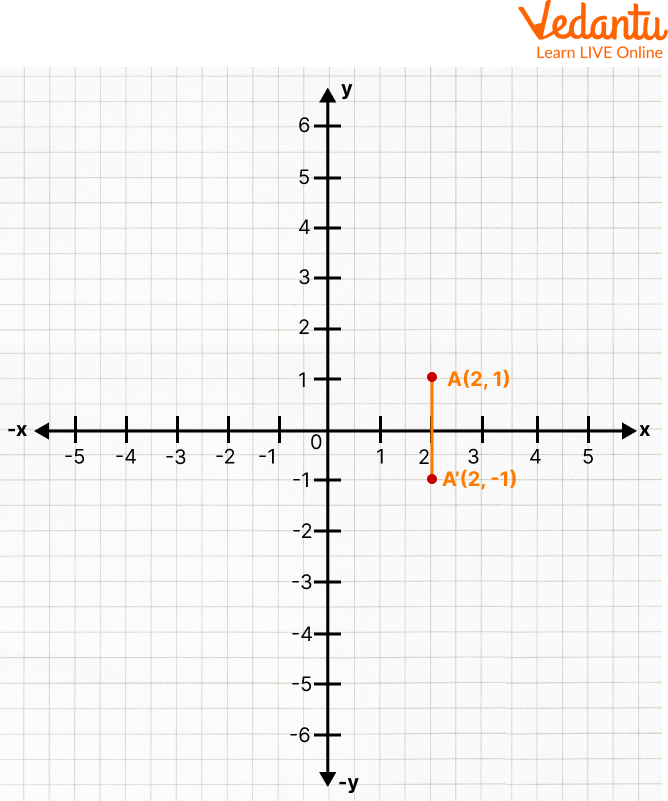




How to Solve Reflection Problems on the X Axis with Examples
Have you ever thought about how you would represent the reflection of a point about the x-axis? This is done using the concept of reflection of a point in the x-axis. If you do not know about it, do not get worried, as this article covers all the concepts of reflection in the x-axis and the rules to find the reflection using attractive images so that the children can easily grasp the topics. Let us begin with our learning.
What is the Reflection of a Point in the x-axis?
Reflection of a point in the x-axis states that when a point is reflected across the x-axis, the x-coordinate remains constant, while the y-coordinate is assumed to be the additive inverse of the given ordinate. For example, a point (x, y) is reflected across the x-axis as (x, -y).

Reflection of a Point About the x-axis
A Point on the x-axis has Coordinates
A point on the x-axis has coordinates in the form of ordered pairs having the form (h, 0), where h is the point on the x-axis. When y = 0, the value of the x-coordinate or abscissa can be anything, irrespective of the value of the ordinate.
Rules to Find the Reflection in the x-axis
There is no hard rule to find the reflection in the x-axis; you just need to do is, to follow these two simple steps, which are given below:
Keep the coordinates of the x-axis fixed
Reverse the sign of the y-coordinate
The obtained value of the x-coordinate and y-coordinate is the reflection of a point about the x-axis.
Solved Examples
Q 1. Find the reflection of a point about the x-axis of the following:
(-1, 6)
(2, 1)
Ans: For part 1, we need to follow the given steps:
Read the coordinates (-1, 6) and find out in which quadrant it lies, i.e. the 2nd quadrant
Mark the value of x = -1 and y = 6 in the appropriate quadrants
Highlight the point and write its coordinates
To find its reflection, keep the abscissa same, i.e. x-coordinate is -1, and take the additive inverse of the ordinate, i.e. -6
Now, choose the quadrant for the new coordinates, i.e. (-1, -6)
Mark the values of x = -1 and y = -6 in the respective quadrants
Highlight the point and write its coordinates
This is how you find the reflection of a point in the x-axis.

Reflection of a Point About the x-axis
For part 2, we need to follow the given steps:
Read the coordinates (2, 1) and find out in which quadrant it lies, i.e. the 1st quadrant
Mark the values of x = 2 and y = 1 in the respective quadrants
Highlight the point and write its coordinates
To find its reflection, keep the abscissa same, i.e. 2 and take the additive inverse of ordinate, i.e. -1
Now, choose the quadrant for the new coordinates, i.e. (2, -1)
Mark the values of x = 2 and y = -1 in the respective quadrant
Highlight the point and write its coordinates
This is how you find the reflection of a point (2,1) on the x-axis.

Reflection in the x-axis
Practice Problems
Q 1. Find the reflection about the x-axis of the point (2, 6).
Ans. (2, -6)
Q 2. Find the reflection of a point on the x-axis of the following:
(-7, -3)
(3, 1)
Ans. (-7, 3)
(3, -1)
Q 3. Compute the reflection of a point on the x-axis of the following:
(4, -5)
(-8, 2)
Ans. (4, 5)
(-8, -2)
Summary
Summing up here with the concept of reflection in the x-axis. This article describes all the topics, including rules to find the reflection, the coordinate of a point on the x-axis, etc. Here we have discussed in depth how to solve the problems based on the reflection of a point in the x-axis. Some practice problems are also assigned to the students along with their answers so they can practice more and gain proficiency in the concept. Hoping you enjoyed reading the article.
FAQs on Reflection of a Point About X Axis: Step-by-Step Guide
1. What is meant by reflection in the x-axis in coordinate geometry?
Reflection in the x-axis is a type of geometric transformation where a point or object is 'flipped' across the horizontal x-axis. The x-axis acts as a mirror line. For any point, its reflection is located at the same perpendicular distance from the x-axis but on the opposite side, while its horizontal position (x-coordinate) remains unchanged.
2. What is the rule or formula for finding the reflection of a point in the x-axis?
The rule for reflecting a point across the x-axis is straightforward. If you have a point with coordinates P(x, y), its reflection, often denoted as P', will have the coordinates P'(x, -y). In simple terms, you keep the x-coordinate the same and negate the y-coordinate (change its sign).
3. Can you give an example of reflecting a point in the x-axis?
Certainly. Let's take the point A(5, 3). To find its reflection in the x-axis, we apply the rule (x, y) → (x, -y). We keep the x-coordinate (5) the same and change the sign of the y-coordinate (3 becomes -3). Therefore, the reflection of point A(5, 3) in the x-axis is the point A'(5, -3).
4. Why does only the y-coordinate change sign during a reflection in the x-axis?
Only the y-coordinate changes sign because reflection in the x-axis is a purely vertical flip. The x-coordinate represents the point's horizontal position relative to the y-axis, which does not change during this transformation. The y-coordinate, which represents the point's vertical distance from the x-axis, is inverted as the point moves to the opposite side of the x-axis 'mirror', thus its sign is negated.
5. How is reflection in the x-axis different from reflection in the y-axis?
The key differences between reflection in the x-axis and y-axis are:
Line of Reflection: For x-axis reflection, the horizontal axis is the mirror. For y-axis reflection, the vertical axis is the mirror.
Coordinate Change Rule: Reflection in the x-axis changes (x, y) to (x, -y). Reflection in the y-axis changes (x, y) to (-x, y).
Invariant Coordinate: In an x-axis reflection, the x-coordinate remains the same (is invariant). In a y-axis reflection, the y-coordinate remains the same.
6. If a point lies directly on the x-axis, what is its reflection?
If a point lies on the line of reflection, it does not move. Any point on the x-axis has coordinates of the form (a, 0). Applying the reflection rule (x, -y), the y-coordinate 0 becomes -0, which is still 0. Therefore, the reflection of the point (a, 0) is the point itself, (a, 0).
7. Does reflecting a point in the x-axis change its distance from the origin (0,0)?
No, the distance from the origin remains unchanged. Reflection is an isometry, which means it is a rigid transformation that preserves distances and angles. Using the distance formula, the distance of P(x, y) from the origin is √x² + y². The distance of its reflection P'(x, -y) is √x² + (-y)², which simplifies to √x² + y². The distances are identical.
8. What is a real-world example of reflection in the x-axis?
A classic real-world example is the reflection of a landscape in a perfectly still body of water. If you consider the water line as the x-axis, the reflection of a mountain peak in the lake is a mirror image. The peak and its reflection are at the same horizontal position, but their vertical positions are opposite relative to the water line. This principle is also fundamental in computer graphics and design for creating symmetrical patterns.









